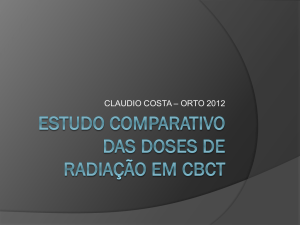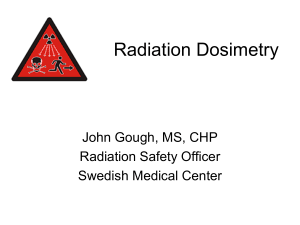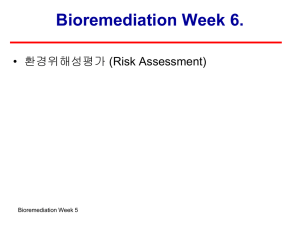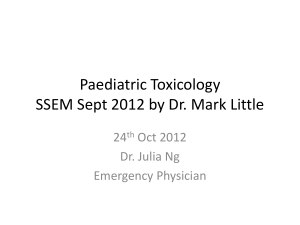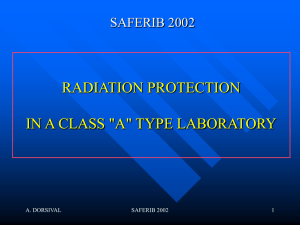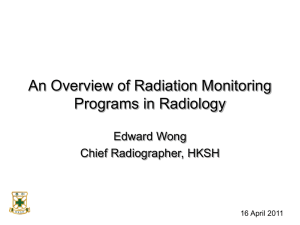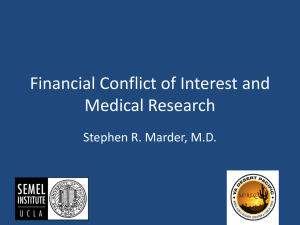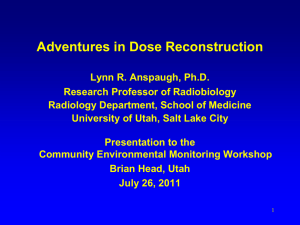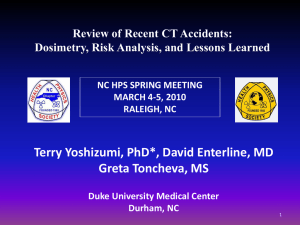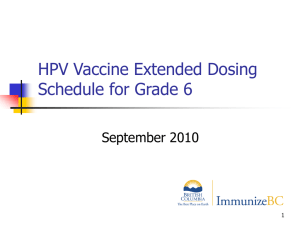Environmental and Radiological Health Sciences
advertisement
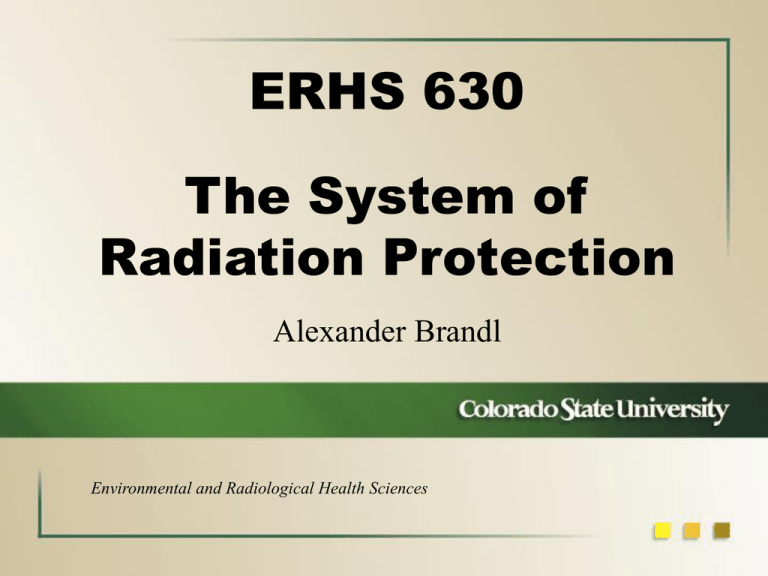
ERHS 630 The System of Radiation Protection Alexander Brandl Environmental and Radiological Health Sciences Progression and Evolution • ICRP 26 • dose limits • occupational exposure • prevention of non-stochastic effects • limitation of stochastic effects • ICRP 60 • exposure (practice and intervention) • occupational, public, medical • proposed and continuing practices • justification, optimization, limitation •ICRP 103 • process- to situation-based • planned, emergency, existing exposure situation Consolidate and Develop • Individual dose limits • 50 mSv a-1 vs. 20 mSv a-1 • ICRP / IAEA and the U.S. • “as low as possible” • “as low as reasonably achievable, economic and social factors being taken into account” – (ALARA) • “as low as reasonably practicable” – (ALARP) ? • ALARA • has resulted in substantial decreases in individual doses • reduced situations where dose limits play major role in system of protection Consolidate & Develop (II) • Why ICRP 103? • skepticism (international, stakeholder) • “improving protection?” • “new scientific basis?” • “change to dose limits?” • Features • updated wR and wT, radiation detriment • maintaining 3 Fundamental Principles • evolution from process- to situation-based approach • maintaining individual dose limits in planned exposures • re-enforcing the principle of optimization; dose and risk constraints (planned) and reference levels (emergency or existing) • including approach for developing framework for protection of the environment Consolidate & Develop (III) • Scope of ICRP 103 • system of radiological protection applies • to all exposures to ionizing radiation, regardless of size and origin • however, source of exposure or pathways leading to dose must be amenable to control • excluded, if deemed not amenable to control with regulatory instruments • exempted, where controls are regarded as unwarranted System of Protection • Characterization of possible exposure situations • Classification of types of exposure • Identification of exposed individuals • Categorization of types of assessment • source-related • individual-related • Precise formulation of the Principles of Protection • Level of individual doses which require protective actions • Conditions for the safety of radiation sources, including security, requirements for emergency preparedness and response Scientific Basis • Review of biological and epidemiological information on health risks • distribution of relative risks for different organs or tissues; most notably for breast cancer and hereditary effects • assuming LNT: combined detriment still 5 % Sv-1 • DDREF unchanged at 2 • prenatal exposure • cancer risk similar to irradiation in early childhood • threshold for induction of malformations and severe mental retardation • retention of dose limits for effective and equivalent dose • further information and revision might be needed (i.e., eye) • data on possible non-cancer diseases insufficient ICRP Conclusions • No fundamental changes to the system of radiation protection needed (ICRP 60) • Numerical recommendations (ICRP 60) mostly remain valid • ICRP 103 should not imply major changes to radiation protection regulations (if based on ICRP 60 and subsequent policy guidance documents) • LNT still basis for summation of doses from external exposure and intake of radionuclides • Doses are calculated using reference computational phantoms; effective dose calculated to Reference Person not an individual Effective Dose • Effective dose • intended for use as protection quantity • prospective dose assessment for planning and optimization, demonstration of compliance with regulatory dose limits • not recommended for epidemiological evaluations, detailed specific retrospective investigations of individual exposure and risk • Collective effective dose • instrument for optimization, comparing radiological technologies and protection procedures • mainly in occupational settings • not intended as a tool for epidemiological risk assessment • inappropriate in risk projections (calculation of cancer deaths from trivial individual doses to be avoided) Exposure Situations • Planned exposure situations • planned introduction and operation of sources • includes situations previously termed “practices” • Emergency exposure situations • unexpected situations requiring urgent attention • occurring during operation of a planned situation • malicious act • Existing exposure situations • already exist when a decision on control has to be taken • natural background radiation Fundamental Principles • Justification • any decision that alters the radiation exposure situation should do more good than harm • Optimization of Protection • the likelihood of incurring exposure, the number of people exposed, and the magnitude of their individual doses should all be kept as low as reasonably achievable, taking into account economic and societal factors • Application of Dose Limits (planned exposures only!) • the total dose to any individual from regulated sources in planned exposure situations other than medical exposure should not exceed the appropriate limits Fundamental Principles (II) • Categories of exposure • occupational • public • upon declaration of pregnancy: embryo / fetus • medical • patients • comforters, carers, volunteers in research Justification • Any decision-making process should explicitly include expected changes in radiation detriment • Consequences considered not confined to radiation protection • need to include other risks, cost-benefit of the activity • Requirement that net benefit be positive! • planned exposures: only to be introduced if net benefit to the individual or society as a whole offsets radiation detriment • emergency or existing exposures: decisions taken to reduce doses should do more good than harm Justification (II) • Some exposure scenarios deemed unjustified by ICRP • deliberate addition or activation of radionuclides in food, beverages, cosmetics, toys, personal jewelry and adornments • radiological examination for occupational, health insurance, or legal purposes undertaken without reference to clinical indications (exceptions: expected important information on the health of the individual, important criminal investigation) • medical screening of asymptotic population groups, unless advantages for the individual or society as a whole outweigh costs and detriment Optimization • Only for justified exposure situations • Source-related process • Aimed at achieving best level of protection under the prevailing circumstances • Iterative process, involving: • evaluation of the exposure situation, including any potential exposures • selection of an appropriate value for constraints or reference levels • identification of potential protection options • selection of the best option (cost-benefit) under the prevailing circumstances • implementation of selected option Limitation • ICRP dose limits • “not” changed from ICRP 60 • (from ICRP 103) Dose Constraints • Key role of optimization emphasized • Restrictions are applied to doses to a nominal individual (Reference Person) • dose constraints • planned exposure situations • reference levels • emergency and existing exposure situations • Options where E constraint, should be rejected at planning stage • applied prospectively (optimization!) • After optimization is completed and E constraint • reasons to be investigated • regulatory action not necessarily prompted Limits and Constraints • Dose limits vs. dose constraints or reference levels • workers and members of the public • (from ICRP 103) Limits and Constraints (II) • Dose limits, dose constraints, and reference levels • (from ICRP 103) Limits and Constraints (III) • Dose constraints and reference levels • (from ICRP 103) Planned Exposures • Previously managed as practices • includes: protection during medical uses of ionizing radiation • patients, comforters, carers, volunteers in biomedical research • Planning of planned exposure situations • to include deviations from normal operating procedures • potential exposures • accidents or malicious events • not planned, but can be anticipated • Designer and user of sources • reduction of likelihood for potential exposures • assessment of likelihood and installation of engineering safeguards Emergency Exposures • Reference levels • residual dose after implementation of measures should be below reference levels • total dose regulator plans not to exceed in an emergency • for optimization use of averted dose • Emergency preparedness • planning for the implementation of optimized protection strategies • purpose: reducing exposures to below the reference level • Emergency response • reference level acts as benchmark for evaluating effectiveness of protective actions • input in establishing need for further actions Existing Exposures • Exposure situations • naturally occurring exposures • past events • past accidents • Protection strategies • often implemented in an interactive, progressive manner • over many years Existing Exposures (II) • Example • 222Rn in dwellings and workplaces • recent epidemiological studies • confirm health risk from radon • provide support for recommendations on protection against radon • national reference levels • for the sake of continuity and practicability • E < 10 mSv a-1 (600 Bq m-3) in dwellings • in workplaces: E reference level • occupational exposure • optimization even if E < reference level Environment • Radiation protection of the environment • previously • concern mainly for transfer of radionuclides through the environment • context of planned exposure situations • protection of the general public • would ensure that other species are not put at risk • scientifically sound framework for protection of the environment in all exposure situations • use of Reference Animals and Plants • doses calculated for reference organisms could be compared to doses known to have specific biological effects (at a given dose rate) • no dose limits

